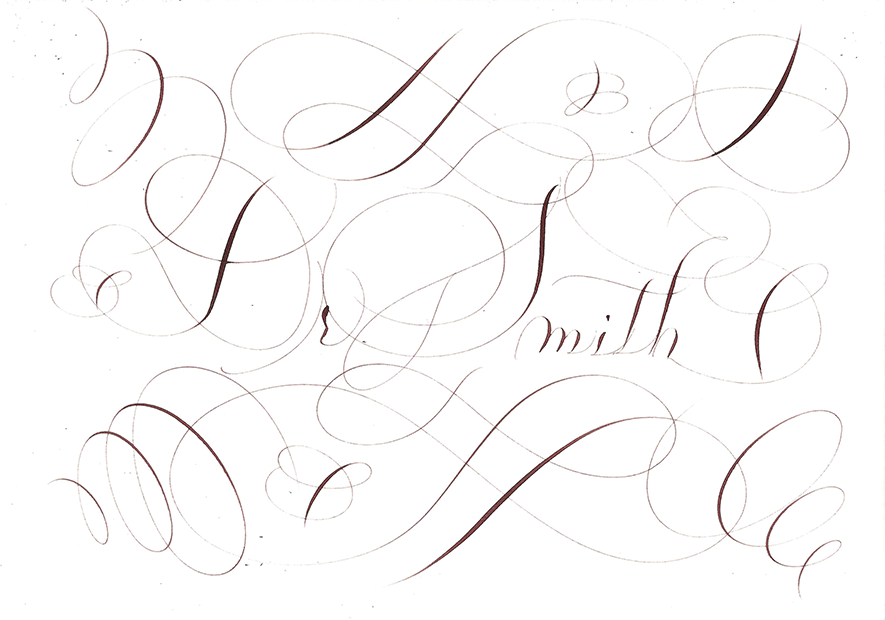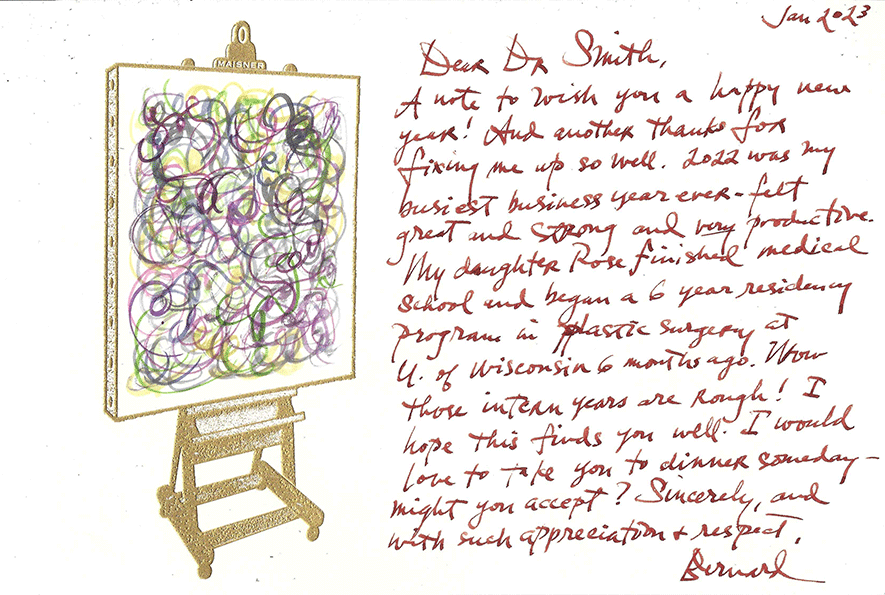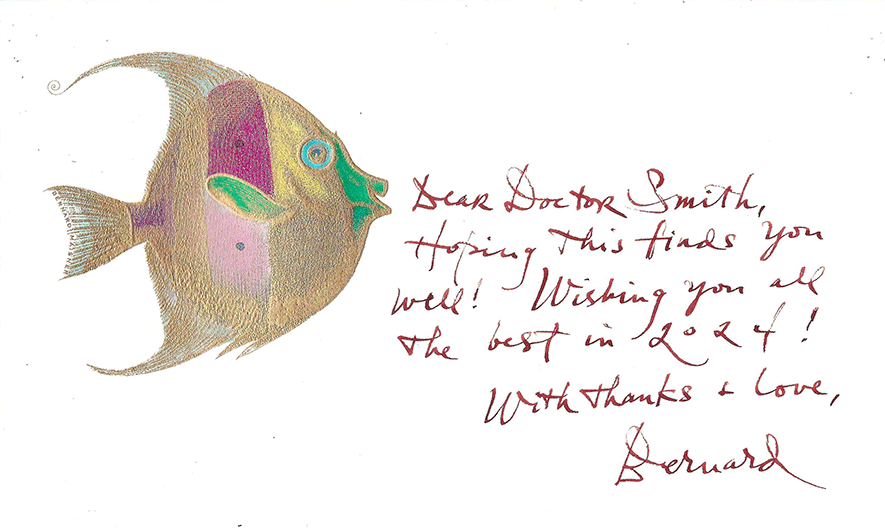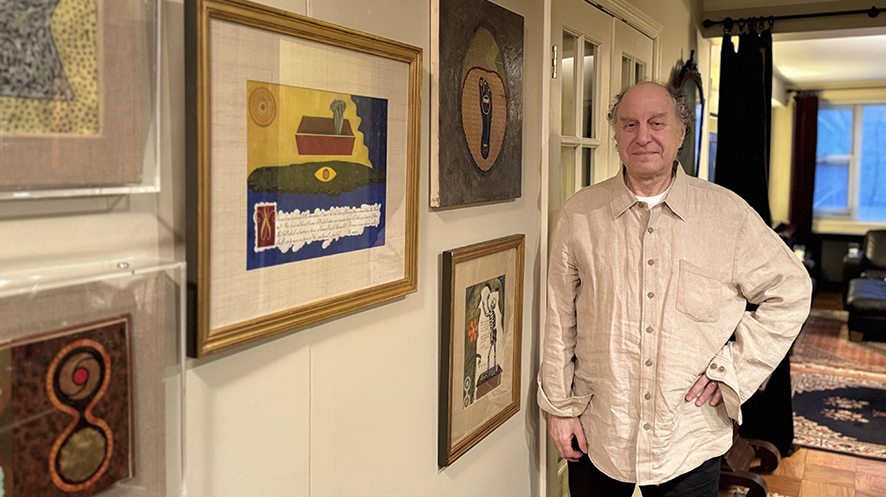You might not know Bernard Maisner by name, but there's a good chance you've seen his work—and his hand.
"I like to say that I'm an actor from my shoulder down," jokes Maisner.
A world-renowned calligrapher, Bernard Maisner had made a long and successful career out of making communication memorable and beautiful. When people want only the very best for their announcements—weddings, graduations, major events—Maisner is the artist you seek out.

His unmistakable style and mastery of his craft have earned him perhaps the world's most interesting side gig: when a movie needs to show someone putting quill to paper, it's often Maisner's hand performing on-screen.
"For me, the fun aspect is creating lettering to make the directors see what they want as writing for their characters, how they picture the writing. In Sleepy Hollow with Tim Burton, I got to play Johnny Depp's hand, plus a nobleman and a farmer. Three different costumes, three different handwriting styles. In the Age of Innocence with Martin Scorsese, I stood in for Daniel Day-Lewis."
"The prop department, the makeup and wardrobe people, they're all amazing. Everybody is so interested and involved in what they do. Obviously, my roles are very small in the scope of these films, but everybody is so friendly and so creative… It's a wonderful experience. And the catering is always fantastic."
Bernard Maisner graduated from The Cooper Union College of Art in New York in 1977 and has been working as an artist ever since. "I never had a job where I worked for somebody. From day one, I was earning a living in lettering. I've always been in business for myself. I'm really a one-man band." He is also an accomplished fine artist, with critically acclaimed exhibitions at galleries worldwide.
Maisner's lettering skills are in high demand, and his workload reflects that. "There can be 20, 30 jobs all going on at once. And each job has much more to it than you might expect.” A single wedding can require ongoing work over the course of a year, from a save-the-date to working on the invites, menus, programs, and last-minute items like place cards. “So it's on and on and on, with many revisions and changes.”

So when he started to notice some changes in his ability to maintain his pace, he initially dismissed it and pushed through. "I was 65 years old and I'd never had any substantial illness or injury. I never had surgery, never even broke a pinky or anything. So I felt I was pretty invincible." But the symptoms quickly became serious and impossible to ignore. "Suddenly I couldn't go up stairs as easily, I couldn't take a walk to the recycling center. Things that you never even think about were suddenly impossible. I'd have to sit down and rest constantly."
Maisner's wife Bonnie was concerned. "My wife realized how much I was struggling more than I did. She was insistent: ‘You had better see a doctor.’ "
Their neighbor, internal medicine specialist and Columbia alum Dr. Gail Zimmerman, helped the Maisners quickly find a cardiologist. At first, the fix looked simple enough: a stent to improve blood flow. But after more tests, it quickly became clear that surgery was necessary. "It was totally unexpected. Other than these moments of exertion, I felt great. And I was super busy, so I resisted the idea."
Maisner eventually sought Dr. Zimmerman’s recommendation for a heart surgeon. She was adamant: the only surgeon she wanted him to see was Dr. Craig Smith. "We listen to everything Gail tells us to do."
At their first appointment, Dr. Smith made an immediate impression. "He's a very serious man and very clearly intelligent." Maisner had written a note with his trademark style that he gave to Dr. Smith, just to "sneak in something to make him stand out." However, it was Dr. Smith's reaction that made the biggest impression. "What was interesting was how he took it. He really studied it, for what seemed like a minute or two. Taking the time, studying the calligraphy, giving it his full attention. I found that remarkable and beautiful."
The surgery was a resounding success. “All the tests showed that the heart muscle itself had no damage whatsoever. It was just bad plumbing."
At the end of the year, Maisner sent a thank-you note: "It's been a year. Thank you so much. I'm still alive. Thanks for taking care of me." Of course, he sent it on a beautiful note card from his hand-painted retail collection and then graphed the outside of the envelope in a super-flourished way with a stamp on it, trusting the post office would deliver.

And yes, Maisner does mail his notes. "That part is important to me. I think it's a beautiful thing to see a postmark, which sets it in time and space. And you see a date and you see the process of writing, sending and receiving something."
And to Maisner's surprise, Dr. Smith wrote back.
"I remembered [Maisner]; he was certainly an engaging person,” said Smith. “And the card he gave me in our first meeting was impressive, to say the least. He wrote me a note post-op around the following Christmas. I have too many patients to be able to stay in contact with them all. But if someone sends me a note, I write them back; I try to make sure I never miss someone. So when somebody writes me a letter, I thank them for giving me an update. I think it's important to acknowledge the specifics of what someone sends me, the effort they put into it.”
In Mr. Maisner's case, that has been all too easy. “The beautiful calligraphy, the envelopes, the cards… It really is a memorable experience to receive something like that.”
The correspondence continues even now, and has evolved from statements of gratitude to updates on family and life. "My daughter started her six-year residency in plastic surgery, so my understanding and respect for the path towards becoming a surgeon continues to grow,” said Maisner. “I enjoyed sharing that with Dr. Smith."
The men have both bonded over each other's books: Dr. Smith's biography and Maisner's collected artwork. Finding parallels is easier than you might think. "It's probably fair to say that I see surgery in general—and cardiac surgery is a great example of it—as more art than science in many respects, even though it's very scientifically grounded."
Maisner is forever grateful to have had Dr. Smith as his surgeon. "I know I'm just one of many that he's worked on, and there's no way I'm as important to him as he is to me. But he became part of my life in a way that nobody else has. I've never been in that kind of life-and-death situation, and I'm forever grateful for his help.
The experience had a profound effect on Maisner, helping him find inspiration and gratitude. "At 65 years old, as a do-it-yourself type and obsessive artist, putting your hands in somebody else's doesn't come easy," says Maisner. "So it never occurred to me to try to pull back or live an easier lifestyle. If anything, it made me want to work even harder. It pulled forth the desire to improve and to be able to contribute more as an artist. I don't take it for granted; you realize that life doesn't go on forever, so you become more aware of your time spent living."
And that is a perspective worth noting.
Related
- “The Sacrament of Utility” Dr. Craig Smith’s 2025 Commencement Address at Case Western Reserve University School of Medicine
- State of the Union: The Stealth Innovations of Modern Surgical Care
- An Interview with Dr. Craig Smith, Heart Surgeon, Chair of Surgery, and Author of Nobility in Small Things

